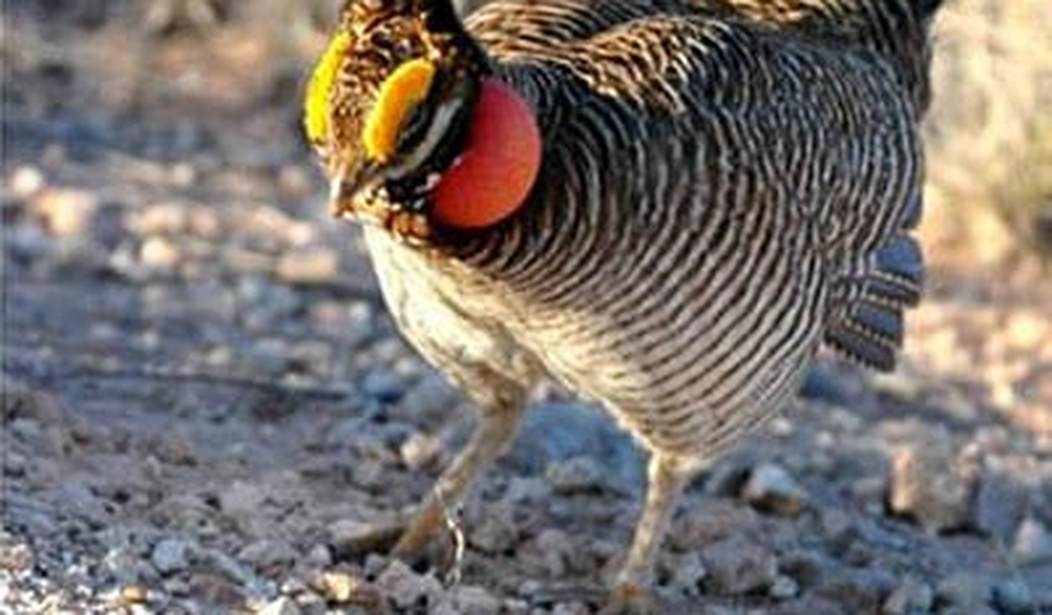The Obama administration wants to make sure that one certain free-range chicken has an easier time crossing the road.
But opponents gearing up for yet another fight with the environmental lobby see yet another proposal from this Interior Department to foul up the economy and kill jobs — forged in a closed-door agreement.
The U.S. Fish and Wildlife Service announced today that it is initiating the process to consider listing the lesser prairie-chicken as a threatened species under the Endangered Species Act.
“We are encouraged by current multi-state efforts to conserve the lesser prairie-chicken and its habitat, but more work needs to be done to reverse its decline,” said Dan Ashe, director of Fish and Wildlife. “Similar to what state and federal partners in this region accomplished when the dunes sagebrush lizard was proposed, we must redouble our important work to identify solutions that provide for the long-term conservation of the species and also help working families remain on the land they have stewarded for generations.”
In announcing the move, Fish and Wildlife said it would make the determination “on the best available science,” though the proposal is open for a 90-day public comment period.
Rep. Steve Pearce (R-N.M.) had a succinct reaction: “Here we go again.”
“Unfortunately, our jobs and our way of life in southern New Mexico continue to come under assault,” said Pearce. “The prairie chicken is yet another example that federal species regulation is not based on science, but rather driven by lawyers for extreme interest groups, like Santa Fe-based WildEarth Guardians, who filed the lawsuit in this case. These groups have filed hundreds of job-killing petitions, often at taxpayer expense, while never having to live with the consequences to the local communities.”
“Listing cannot come soon enough for the lesser prairie-chicken,” said Taylor Jones, endangered species advocate for WildEarth Guardians. “Threats are increasing, the species’ range is contracting, and current conservation efforts are too little, too late to conserve the species.”
“Once found in abundant numbers across much of the five states of Colorado, New Mexico, Texas, Oklahoma and Kansas,” Fish and Wildlife said, “the lesser prairie-chickens’ historical range of native grasslands and prairies has been reduced by an estimated 84 percent.” Only WildEarth Guardians, though, clarifies that this decline has been happening since the 1800s.
“The lesser prairie-chicken will disappear forever without protection of the Endangered Species Act,” said Jay Lininger, an ecologist with the Center for Biological Diversity. “Voluntary measures that preserve a little habitat are convenient for some, but they won’t be effective for the prairie-chicken.”
The chicken was first plucked out of the crop of species potentially needing protection by the ESA in 1998. The state of Colorado has already listed the species as threatened.
The grouse is endangered by grazing livestock infringing on its habitat, agriculture, oil and gas extraction, herbicides, wildfires and controlled burns, drought, and “habitat fragmentation” from fences and power lines, according to environmentalists. Roads, mining, wind energy production, and mating in Kansas with the greater prairie-chickens are also cited as affecting the bird. The Audubon Society cites high mortality rates in Oklahoma and New Mexico from “fence collisions,” and “reduced reproductive success” from “tall structures” on prairie land.
The Interior Department has also been wanting to turn the Lesser Prairie Chicken Preserve about 50 miles east of Roswell in New Mexico into a national monument.
House Natural Resources Committee Chairman Doc Hastings (R-Wash.) said listing the chicken “could have potentially devastating job and economic impacts.”
“Energy projects, including renewable wind energy, would be placed in jeopardy, facing inevitable delay and uncertainty due to new layers of regulatory red tape,” Hastings said. “The proposed listing also ignores the $50 million in habitat protection activities that states have invested over the past several years for the lesser prairie-chicken and creates a disincentive for future cooperative species recovery.”
“This proposed listing is a prime example of how the ESA is being driven by litigation instead of science. The Lesser Prairie Chicken was one of hundreds of species included in a settlement agreement between the Department of the Interior and litigious environmental organizations,” the chairman continued. “Closed-door negotiations with high-paid lawyers whose fees are being subsidized by American taxpayers are not the proper way to make decisions on species listings and set a dangerous precedent that will have widespread impacts on job creation, economic growth and energy security.”
The Institute for Energy Research called today’s action “the latest example of the consequences of the Obama administration’s ‘sue and settle’ strategy, in which the administration and special interest groups negotiate friendly settlements that give both parties what they want.”
In fact, the chicken is but one of 250 species that will be reviewed for listing under the ESA, as agreed to in the settlement.
“Multiply today’s action by 250, and it is easy to get the sense that the president’s ‘all of the above’ energy plan is empty rhetoric,” said IER Senior Vice President for Policy Daniel Kish. “Under these policies, the most endangered species in the United States could become American jobs.”
“I am confident that the Fish and Wildlife Service has learned through the dunes sagebrush lizard case that New Mexico successfully protects our species through local, state and regional agreements,” Pearce said. “I have always supported these conservation efforts, and I will continue to hold the Fish and Wildlife Service accountable to allow a balanced, local approach that protects the species without threatening New Mexico’s jobs.”









Join the conversation as a VIP Member